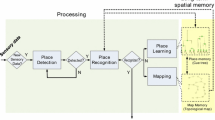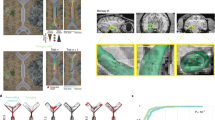Abstract
We propose a memory architecture that is suited to solve a specific task, namely homing, that is finding a not directly visible home place by using visually accessible landmarks. We show that an agent equipped with such a memory structure can autonomously learn the situation and can later use its memory to accomplish homing behaviour. The architecture is based on neuronal structures and grows in a self-organized way depending on experience. The basic architecture consists of three parts, (i) a pre-processor, (ii) a simple, one-layered feed-forward network, called distributor net, and (iii) a full recurrently connected net for representing the situation models to be stored. Apart from Hebbian learning and a local version of the delta-rule, explorative learning is applied that is not based on passive detection of correlations, but is actively searching for interesting hypotheses. Hypotheses are spontaneously introduced and are verified or falsified depending on how well the network representing the hypothesis approaches an internal error of zero. The stability of this approach is successfully tested by removal of one landmark or shifting the position of one or several landmarks showing results comparable to those found in biological experiments. Furthermore, we applied noise in two ways. The trained network was either due to sensory noise or to noise applied to the bias weights describing the memory content. Finally, we tested to what extent learning of the weights is affected by noisy input given to the sensor data. The architecture proposed is discussed to have some at least superficial similarity to the mushroom bodies of insects.
Similar content being viewed by others
References
Arena P, Cruse H, Fortuna L, Lombardo D, Patané L, Rapisarda R (2007) Adaptive bioinspired landmark identification for navigation control. In: Arena P, Rodríguez-Vázquez Á, Liñán-Cembrano G (eds) Bioengineered and bioinspired systems III. Proceedings of SPIE, vol 6592, pp 65920L-1–65920L-12
Beer RD (2006) Parameter space structure of continuous-time recurrent neural networks. Neural Comput 18: 3009–3051
Brooks RA (1991) Intelligence without reason. In: Myopoulos J, Reiter R (eds) Proceedings of the 12th international joint conference on artificial intelligence (IJCAI-91). Morgan Kaufmann, San Mateo, pp 569–595
Collett TS, Collett M (2002) Memory use in insect visual navigation. Nat Rev Neurosci 3: 542–552
Collett M, Collett TS, Bisch S, Wehner R (1998) Local and global vectors in desert ant navigation. Nature 394: 269–272
Cruse H (2003a) A recurrent network for landmark-based navigation. Biol Cybern 88: 425–437
Cruse H (2003b) The evolution of cognition—a hypothesis. Cogn Sci 27: 135–155
Cruse H (2006) Neural networks as cybernetic systems, 2nd edn. Minds, Brains & Media. http://www.brains-minds-media.org
Feynman R (2001) In: Hawking SW The Universe in a Nutshell. Bantam Press, New York
Fogassi L, Ferrari PF, Gesierich B, Rozzi S, Chersi F, Rizzolatti G (2005) Parietal lobe: from action organization to intention understanding. Science 308: 662–667
Franz MO, Mallot HP (2000) Biomimetic robot navigation. Robot Auton Syst 30: 133–153
Gallistel CR, Fairhurst S, Balsam P (2004) The learning curve: implications of a quantitative analysis. PNAS 101(36): 13124–13131
Giurfa M, Zhang S, Jennett A, Menzel R, Srinivasan M (2001) The concepts of “sameness” and “difference” in an insect. Nature 410: 930–933
Grünewald B (1999a) Morphology of feedback neurons in the mushroom body of the honey bee, Apis mellifera. J Comp Neurol 404: 114–126
Grünewald B (1999b) Physiological properties and response modulations of mushroom body feedback neurons during olfactory learning in the honey bee Apis mellifera. J Comp Physiol A 185: 565–576
Harris KD (2008) Stability of the fittest: organizing learning through retroaxonal signals. Trends Neurosci 31: 130–136
Hawking SW (2001) The Universe in a nutshell. Bantam Dell, Westminster
Heisenberg M (2003) Mushroom body memoir: from maps to models. Nat Rev Neurosci 4: 266–275
Hochner B, Shomrat T, Fiorito G (2006) The Octopus: a model for a comparative analysis of the evolution of learning and memory mechanisms. Biol Bull 210: 308–317
Huber F (1960) Untersuchungen über die Funktion des Zentralnervensystems und insbesondere des Gehirns der Grillen. Z vergl Physiol 44: 60–132
Kindermann T (2002) Behavior and adaptability of a six-legged walking system with highly distributed control. Adapt Behav 9: 16–41
Kühn S, Beyn W-J, Cruse H (2007) Modelling Memory Functions with Recurrent Neural Networks consisting of Input Compensation Units. I. Static Situations. Biol Cybern 96: 455–470
Kühn S, Cruse H (2007) Modelling memory functions with recurrent neural networks consisting of input compensation units. II. Dynamic situations. Biol Cybern 96: 471–486
Li Y, Strausfeld NJ (1999) Multimodal efferent and recurrent neurons in the medial lobes of cockroach mushroom bodies. J Comp Neurol 409: 647–663
Makarov VA, Song Y-L, Velarde MG, Hübner D, Cruse H (2008) Elements for a general memory structure: Properties of recurrent neural networks used to form situation models. Biol Cybern 98: 339–351
Mataric MJ (2002) Situated robotics. Encyclopedia of Cognitive Science, Nature Publ., Macmillan Reference Limited
McFarland D, Bösser T (1993) Intelligent behavior in animals and robots. MIT Press, Cambridge
Menzel R, De Marco RJ (2006) Spatial memory, navigation and dance behaviour in Apis mellifica. J Comp Physiol A 192: 889–903
Mizunami M, Weibrecht J, Straussfeld N (1998a) Mushroom bodies of the cockroach: Activitiey and identities of neurons recoreded in freely moving animals. J Comp Neurol 402: 501–519
Mizunami M, Weibrecht J, Straussfeld N (1998b) Mushroom bodies of the cockroach: their participation in place memory. J Comp Neurol 402: 520–537
Möller R (2001) Do insects use templates or parameters for landmark navigation?. J Theor Biol 210(1): 33–45
Slocum AC, Downey DC, Beer RD (2000) Further experiments in the evolution of minimally cognitive behavior: from perceiving affordances to selective attention. In: Meyer J, Berthoz A, Floreano D, Roitblat H, Wilson S (eds) From animals to animats 6: Proceedings of the Sixth International Conference on Simulation of Adaptive Behavior. MIT Press, Cambridge, pp 430–439
Schilling M, Cruse H (2008) The evolution of cognition—from first order to second order embodiment. In: Wachsmuth I, Knoblich G (eds) Modeling communication with robots and virtual humans. Lecture Notes in Artificial Intelligence. Springer, Berlin, pp 77–108
Schwaerzel M, Monastirioti M, Scholz H, Friggi-Grelin F, Birman S, Heisenberg M (2003) Dopamine and octopamine differentiate between aversive and appetitive olfactory memories in Drosophila. J Neurosci 23: 10495–10502
Steels L (1996) Discovering the competitors adaptive behavior 4: 173–199
Steels L (1997) A selectionist mechanism for autonomous behavior acquisition. Rob Auton Syst 20: 117–131
Steels L (2001) The talking heads experiment. In: Obrist HU, Vanderlinden B (eds) Laboratorium. Dumont Verlag, Cologne, pp 413–419
Steinkühler U, Cruse H (1998) A holistic model for an internal representation to control the movement of a manipulator with redundant degrees of freedom. Biol Cybern 79: 457–466
Strauss R, Pichler J (1998) Persistence of orientation toward a temporarily invisible landmark in Drosophila melanogaster. J Comp Physiol A 182: 411–423
Tang S, Wolf R, Xu S, Heisenberg M (2004) Visual pattern recognition in Drosophila is invariant for retinal position. Science 305: 1020–1022
Wehner R (2003) Desert ant navigation: how miniature brains solve complex tasks. J Comp Physiol A 189: 579–588
Wessnitzer J, Webb B (2006) Multimodal sensory integration in insects—towards insect brain control architectures. Bioinsp Biomim 1: 63–75
Widrow B, Hoff M (1960) Adaptive switching circuits. In: Anderson J, Rosenfeld E (1988) Neurocomputing: foundations of Research. MIT Press, Cambridge
Zarandy A, Rekeczky C (2005) Bi-i: a standalone ultra high speed cellular vision system. IEEE Circuits Syst Mag 5(2): 36–45
Author information
Authors and Affiliations
Corresponding author
Rights and permissions
About this article
Cite this article
Cruse, H., Hübner, D. Selforganizing memory: active learning of landmarks used for navigation. Biol Cybern 99, 219–236 (2008). https://doi.org/10.1007/s00422-008-0256-7
Received:
Accepted:
Published:
Issue Date:
DOI: https://doi.org/10.1007/s00422-008-0256-7




